It seems always that at this time of year I need to tread lightly and sometimes listen to the voice of reason within my head ---(voice in head droning on in a monotone voice) “You have to remember; these people cure and cook at home, not like you on a commercial bases”
I have been cooking since I was five (mum and dad out somewhere don’t nowhere) roast beef and Yorkshire puddings, gravy wiv smashed potatoes (1 pound of butter and fresh cow’s milk) as well as roasted one along wiv three veg. I seem to have this uncanny knack (besides annoying people) of seeing things that to me are plain as day and where others cannot see the wood for the trees. Curing is one of them things but that’s for another day.
First and foremost I will say that it is/was not my intention to call down such a well esteemed and knowable and liked person and also a long time member, But.
After discussions on fb (yes I have a page where the good food porn goes) with Ruralidle on the pros and cons of cooking a ham it got m a thinking, a well esteemed friend of mine (CFIA) on fb asked if I could do a York ham like he used to get from me for a client over on Vancouver Island.
The ham is ready to be cooked and so it is I will follow the steps along the way recording each and every pause that may or may not happen
Keep watch on this space
Cooking Hams
57 posts
• Page 1 of 4 • 1, 2, 3, 4
Cooking Hams
But what do I know
-

BriCan - Registered Member
- Posts: 2203
- Joined: Wed Apr 07, 2010 12:07 am
- Location: West Coast of Canada
Well things as they may be I did find time within my somewhat hectic schedule to do some things on the side other than trying to get some sleep. It seems that the reaction of saying that one can over cook a ham (roast beef or lamb let alone chicken) seems imposable – in this instance ham is the one in question
Ruralidle and I discussed the pros and cons one night on fb and was given a complement to which I returned ‘I seem to have a knack (??) call it what you like but I tend to see things for what they are’. We disused the cooking of hams and to my comeback of hams being over cooked at
(which is 156 degrees F) the discussion went to
from there to
In 1991 I pulled the Gammon cure out of the UK to use in my shop, the last time I had done Gammon was in 65/66 while helping a friend out (Maisons Pork Butchers Abingdon Street Market) I did remember the cooking times as we went to the pub Sunday lunch time (3 hours) so like everyone else I put a temperature probe in and cooked to what I assumed was right – ‘pork – 160 degrees F’ ---- well it was pork – ham is when its cooked --- right?? --- ‘Not’
The ham was over cooked as well as on the dry side not to mention the weight loss
Upon checking the probe I noticed that hams was at 145 degrees F and knowing that we have to archive an internal temperature of 160 degrees F to fall within the food safe guidelines this is how I cook ‘all’ hams except 'hot smoked'
The following is the steps/procedure that I use.
Cooking the ham in a roasting pan uncovered with water. Please note the temperature and time to cook. 4 hours to cook, temperature set to 145 degrees F and internal is at 60 degrees F
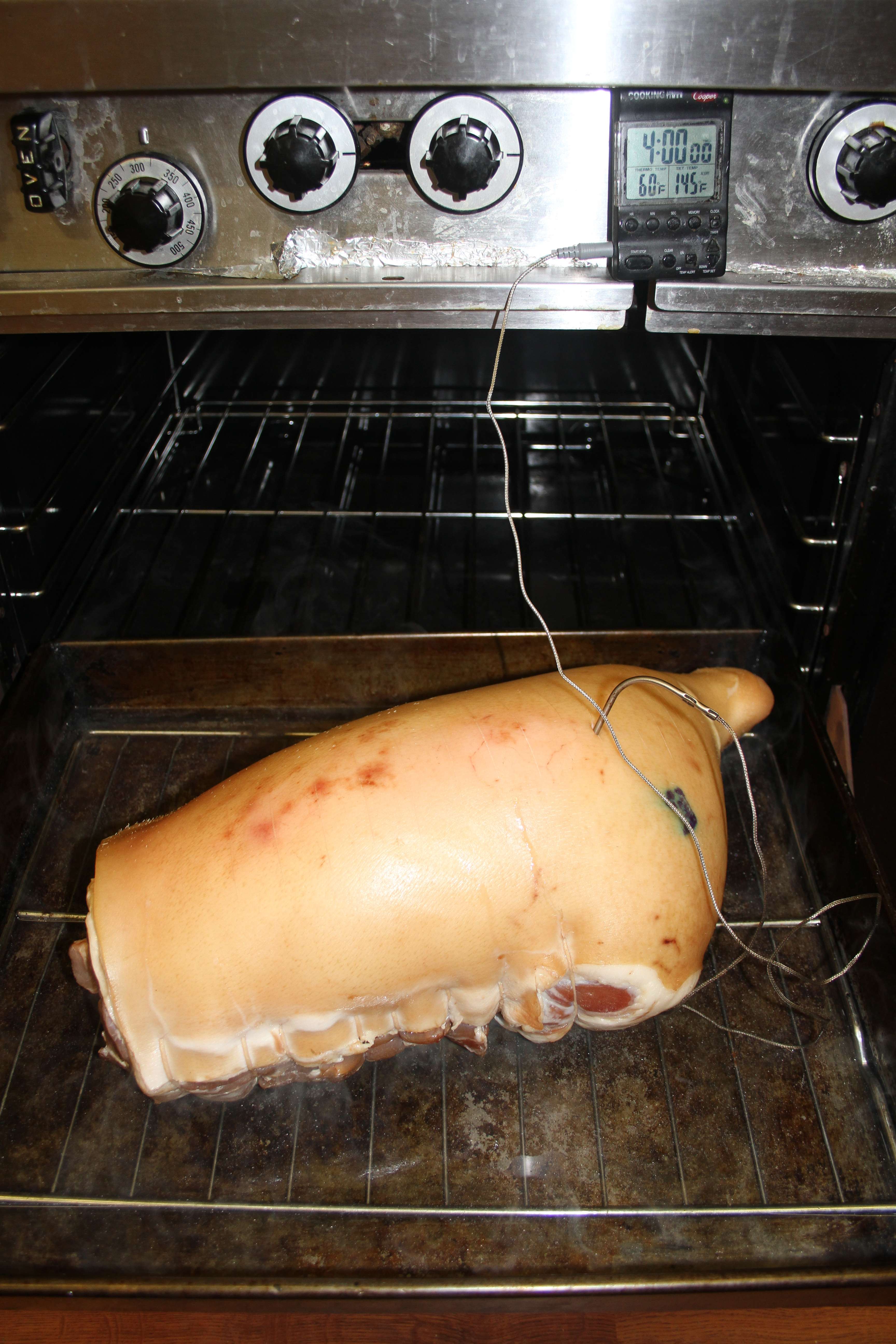
Into the oven – note the timer/temperature 4 hours to cook, temperature set to 145 degrees F and internal is down to 59 degrees F
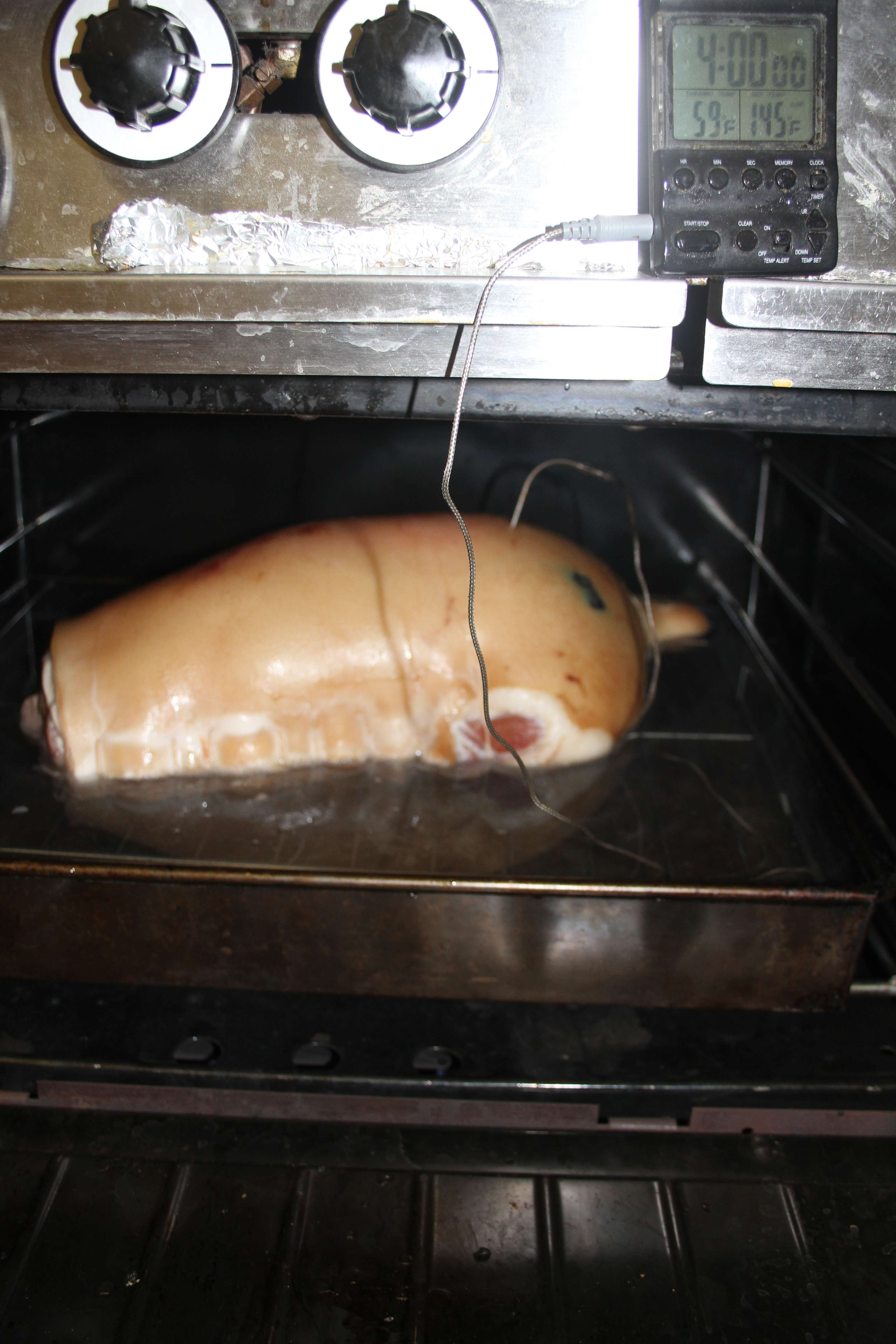
3 hours to go and the internal temperature is now up to 62 degrees F
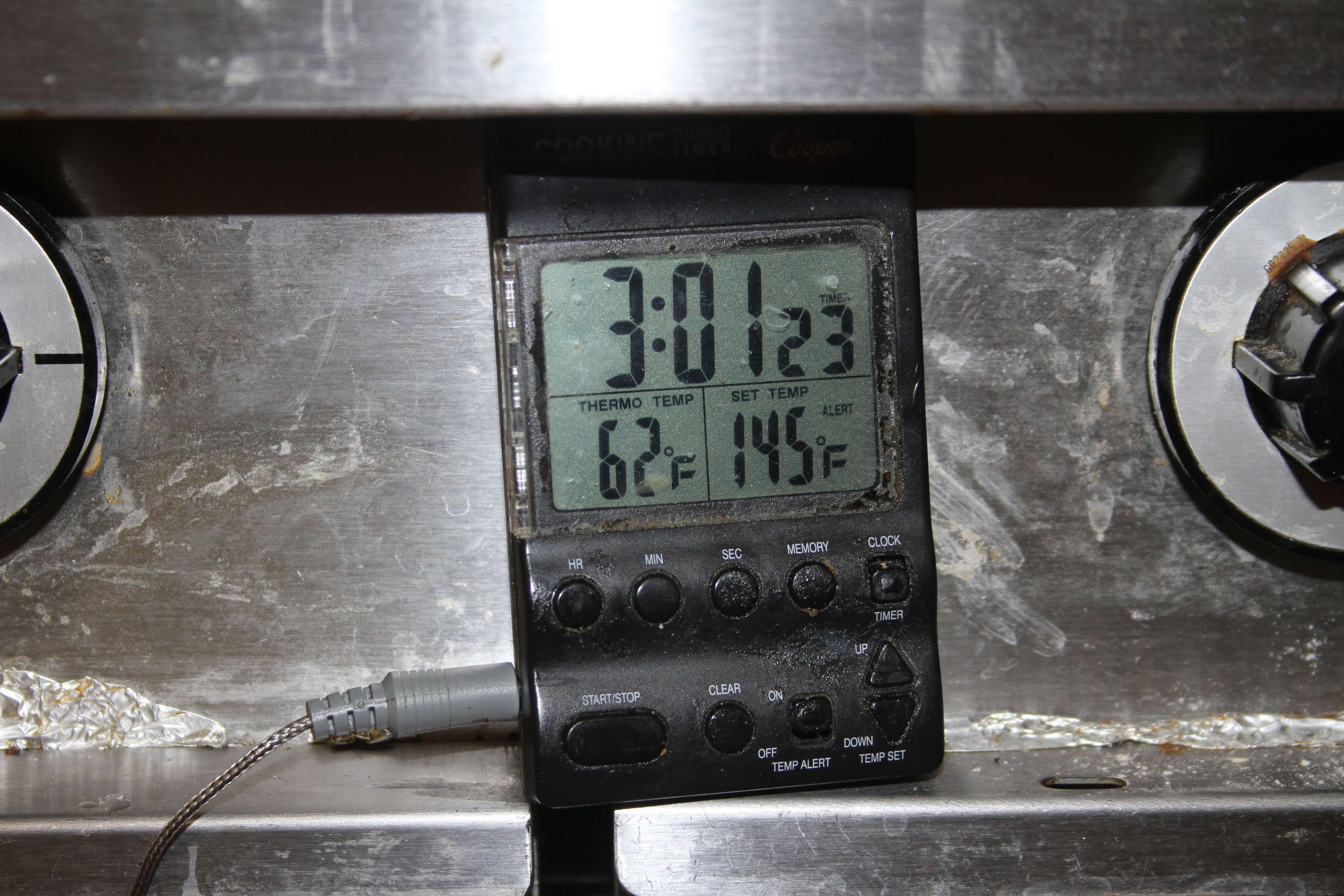
Temperature on oven (gas) set to 300 degrees F
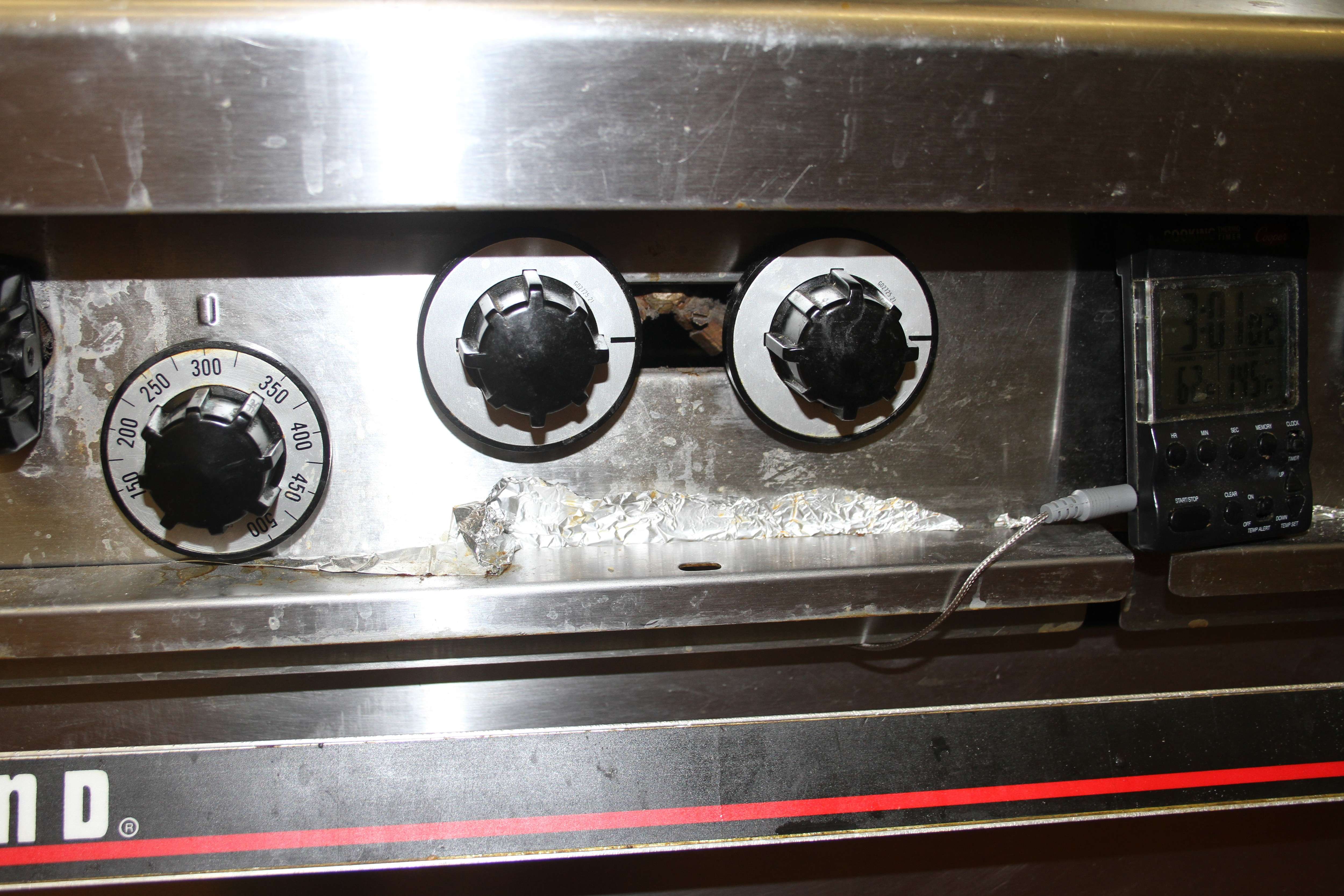
2 hours in and the internal temperature is now at 73 degrees F
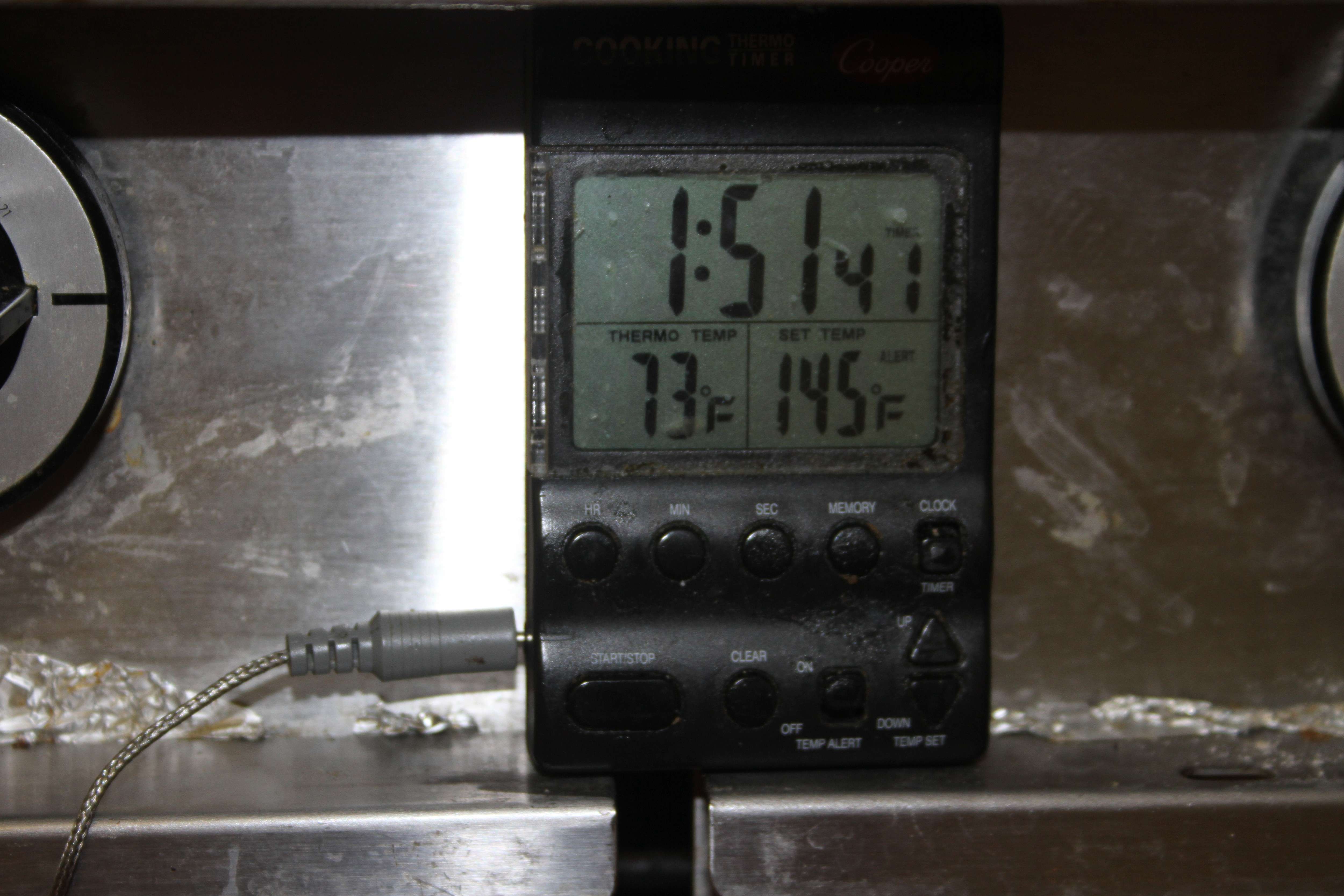
25 minutes and 1 second to go and now we are sitting at 99 degrees F internal
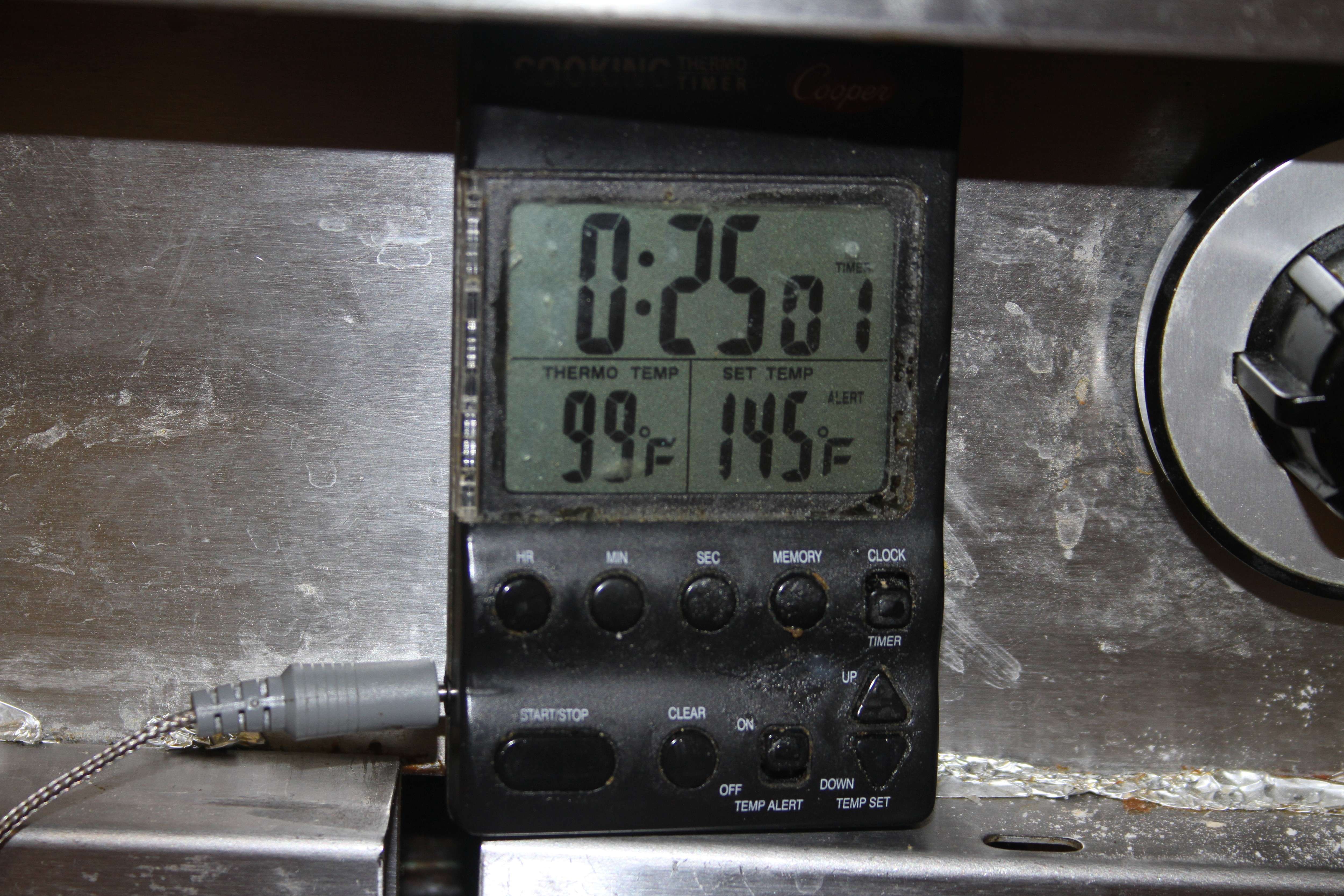
+ 25 minutes and 24 seconds internal temperature is sitting at 117 degrees F
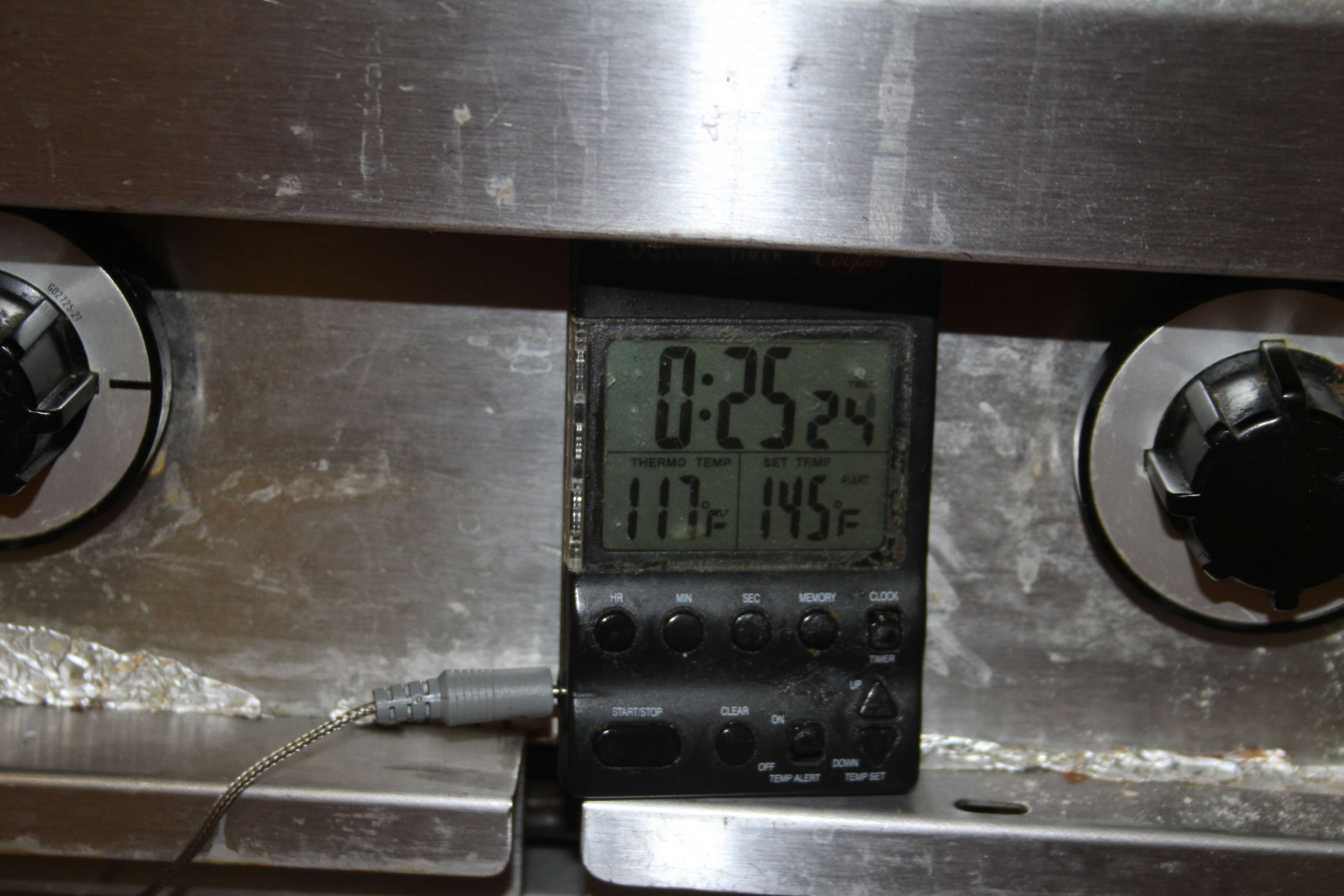
+ 1 hour 37 minutes and 4 seconds Internal temperature is now sitting at 140 degrees F
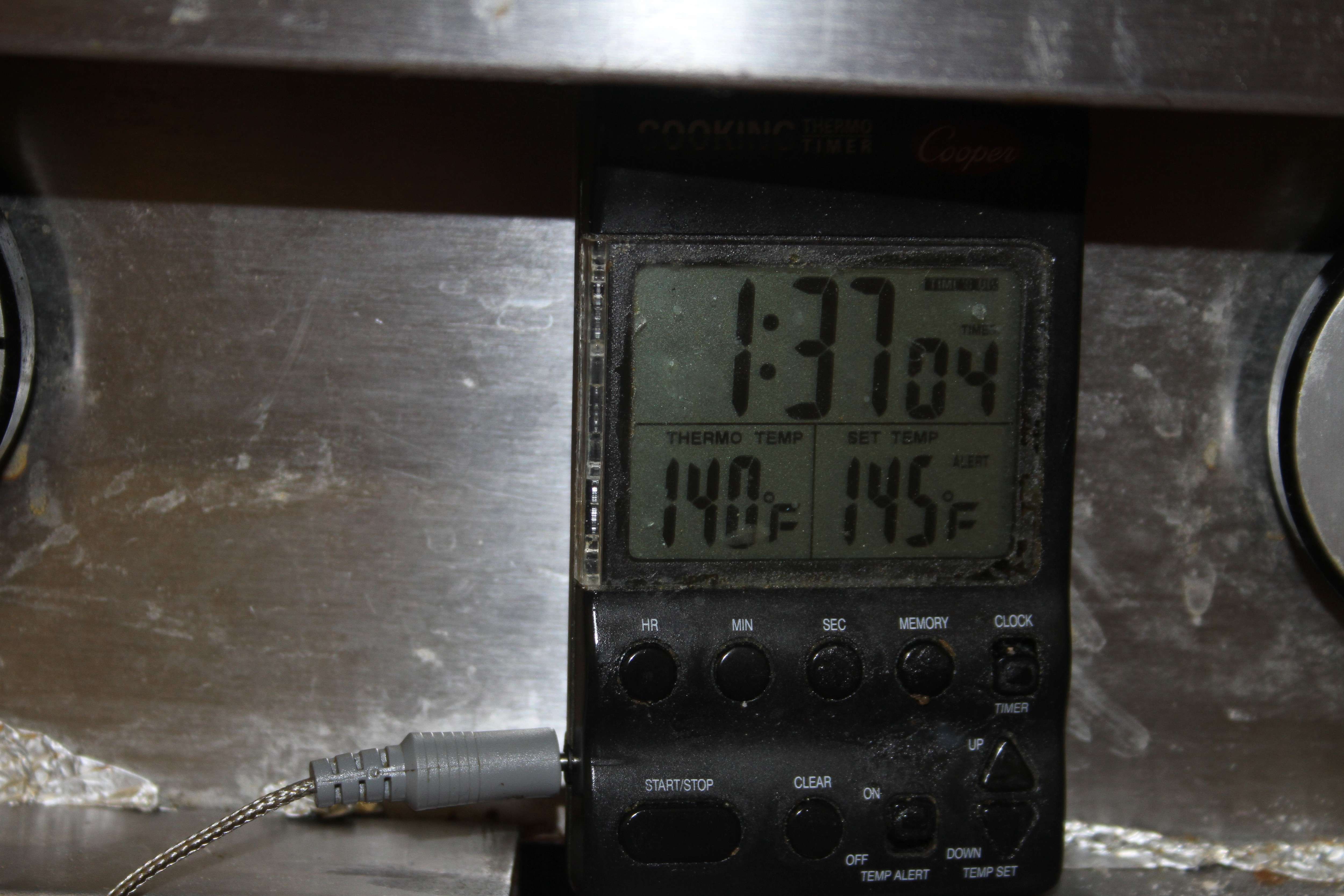
+ 1 hour and 54 minutes and 11 seconds internal temperature has got to 145 degrees F internal
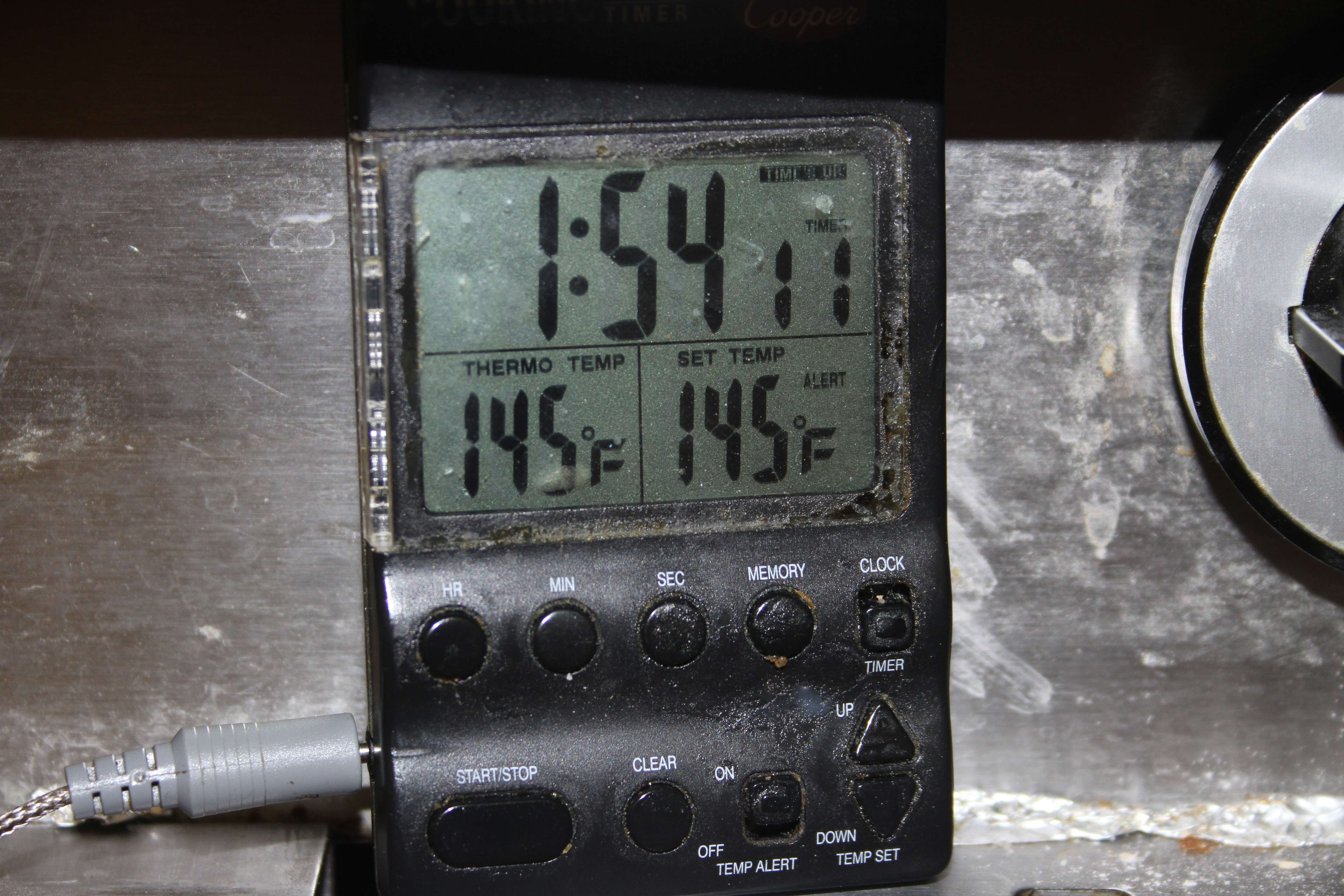
Cooked
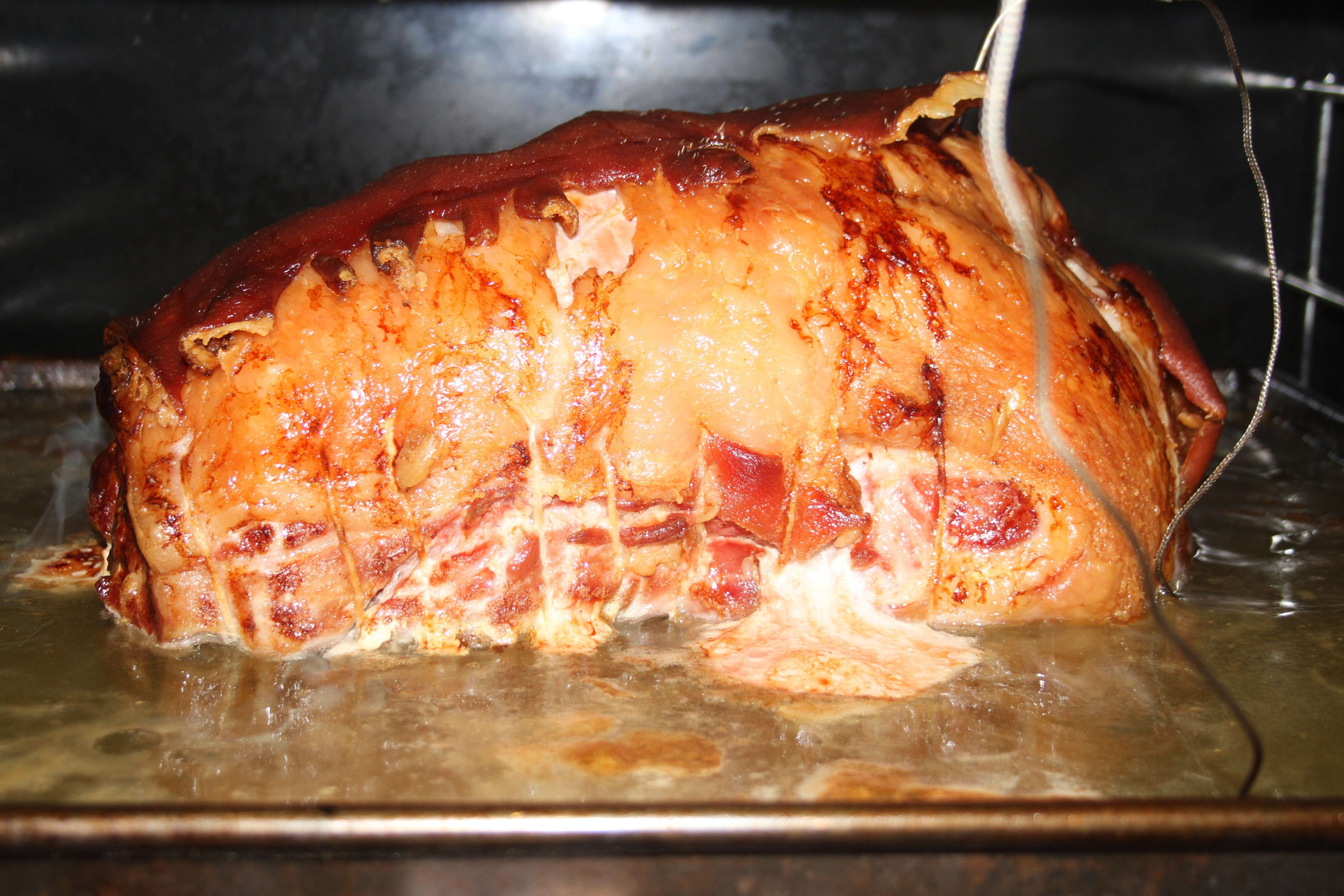
Had to change probe to make sure of the internal temperature Note the temperature is set for 160 degrees F internal probe is reading 149 degrees F and we are 2 minutes and 7 seconds into time
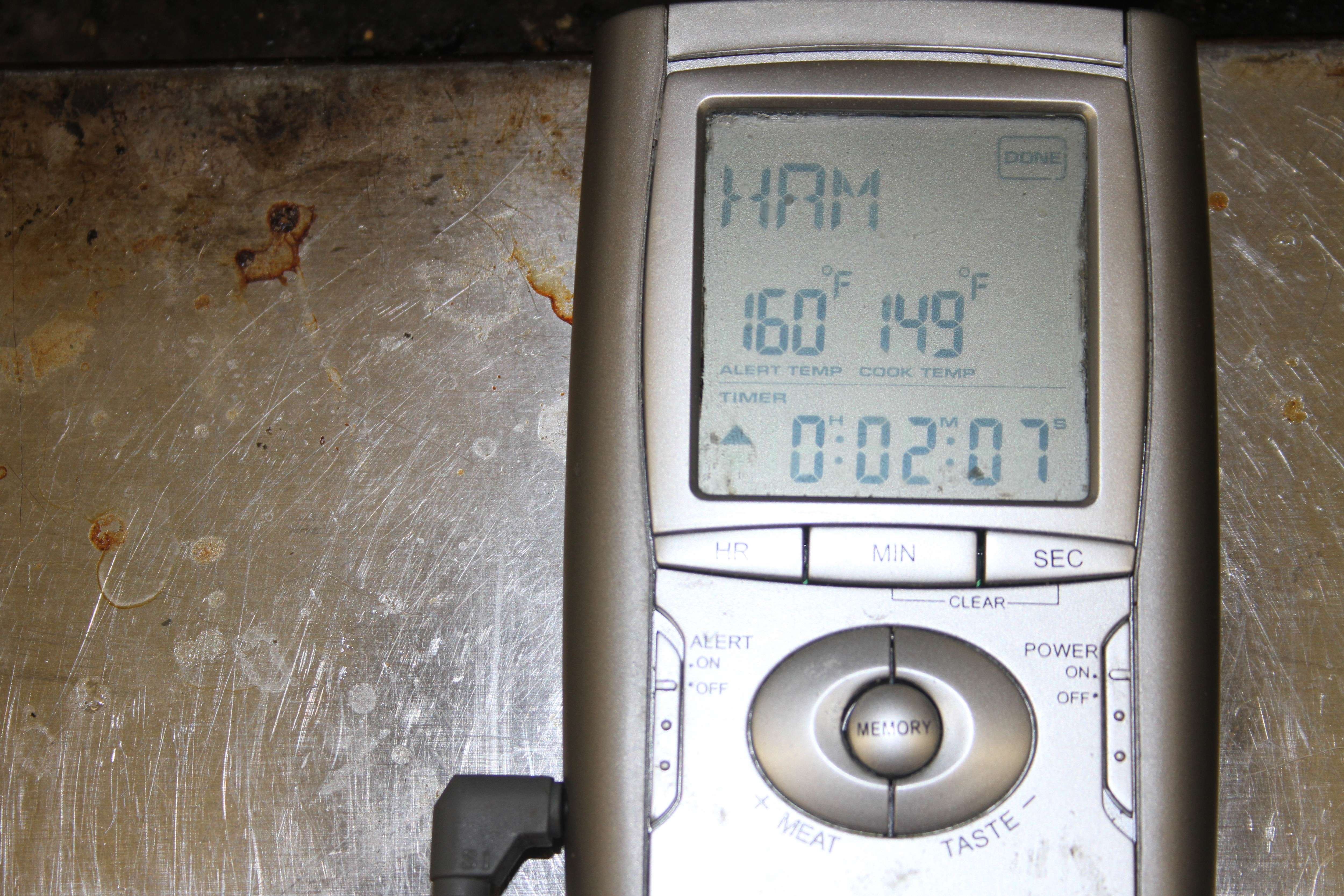
+ 39 minutes and 51 seconds in and we have archived 160 degrees F internal temperature which is needed

Just to show you what happens when you cook to 156 degrees F
+ 1 hour and 3 minutes and 49 seconds internal has reached 165 degrees internal
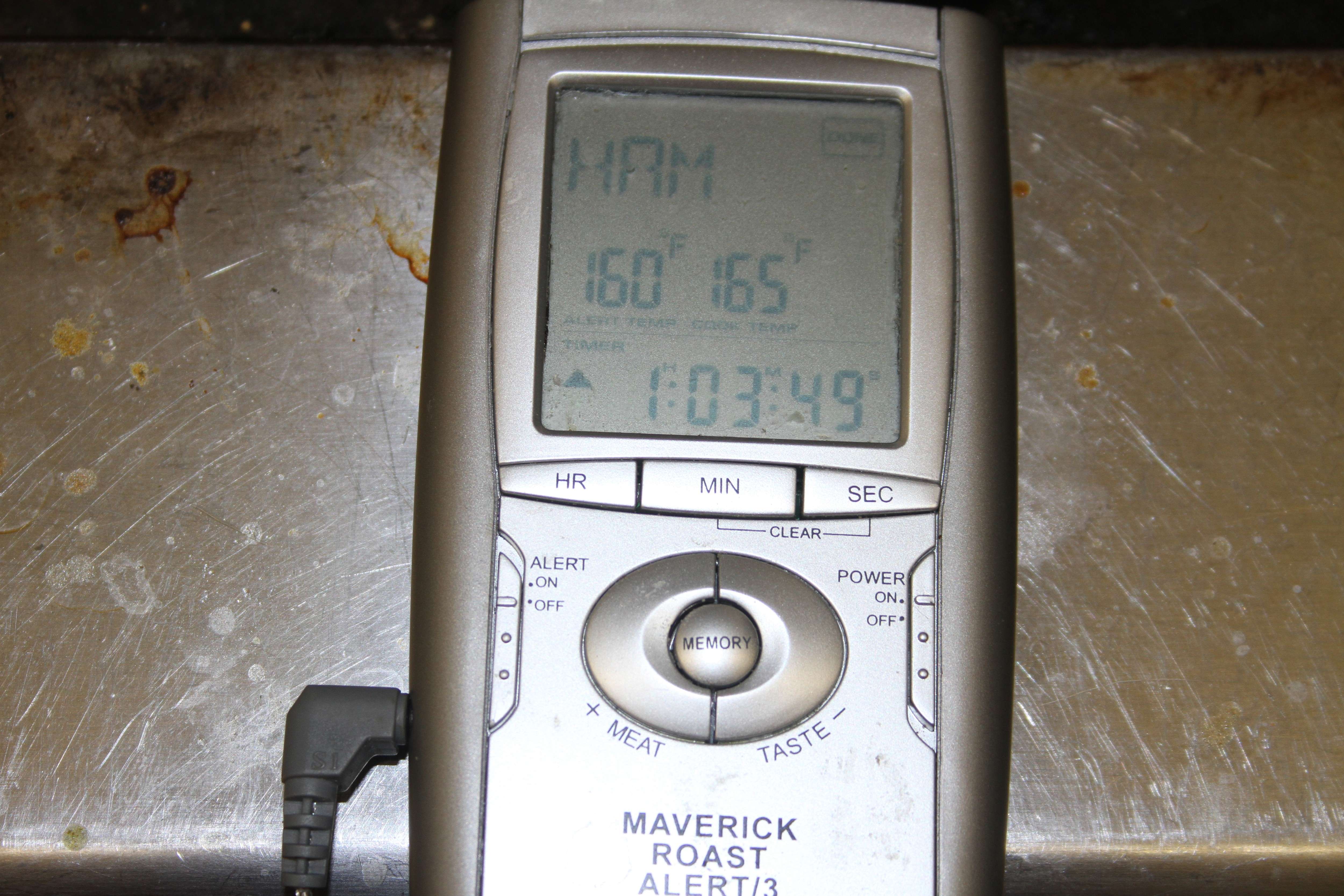
+ 1 hour and 45 minutes and 9 seconds internal is now at 169 degrees F
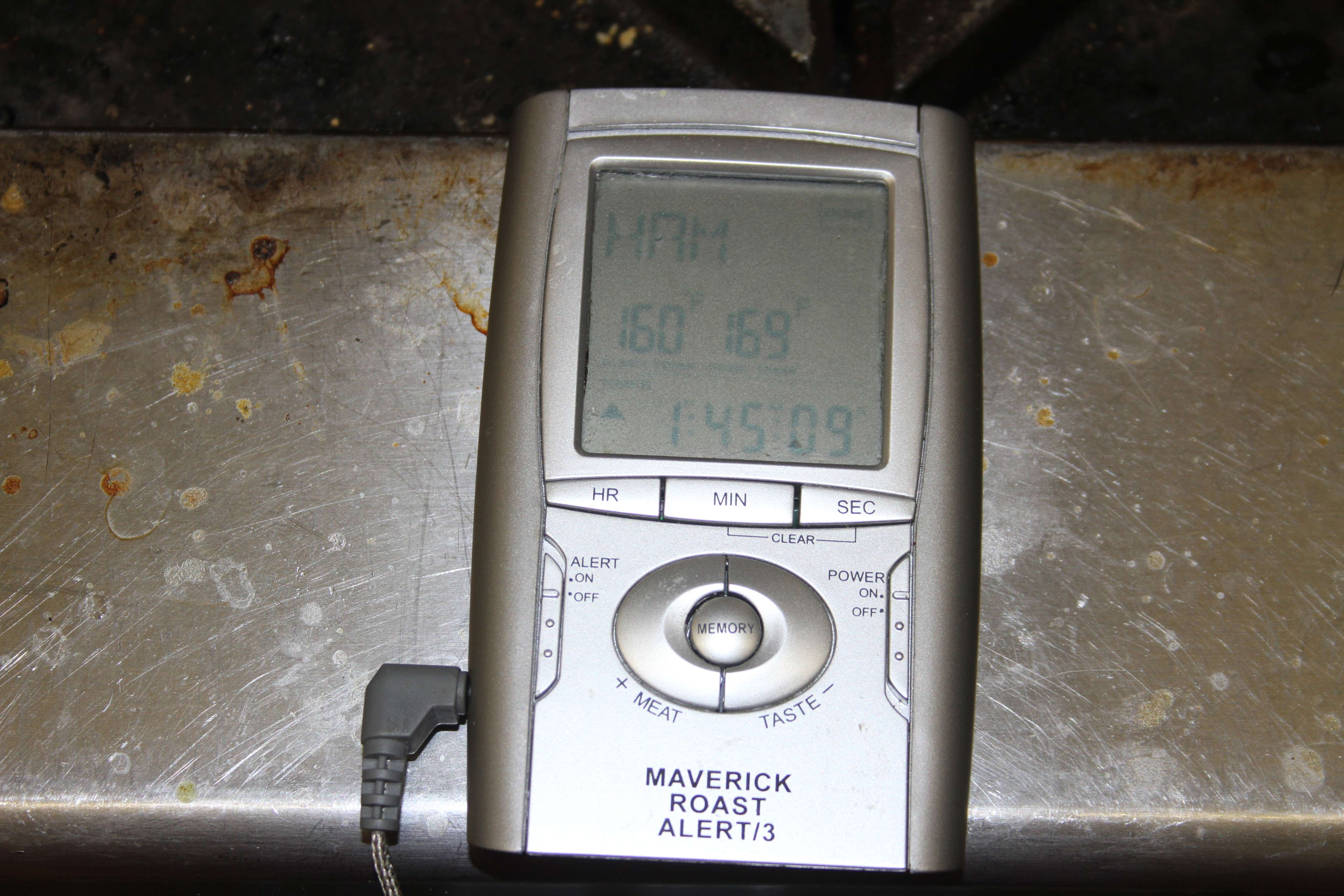
After the ham had cooled in the liquid it’s transferred to the tray
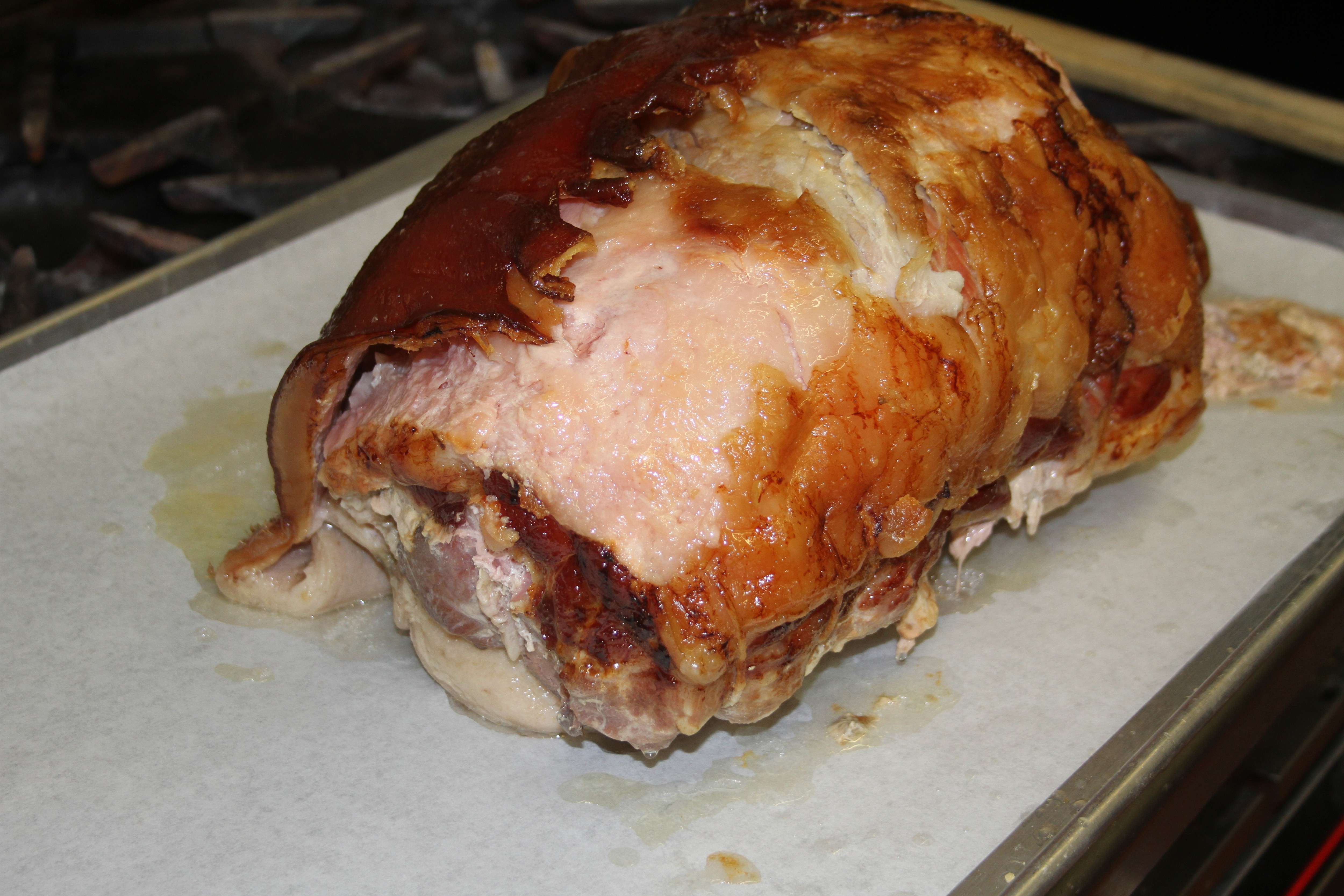
Hope that this has been of some hope to people
Ruralidle and I discussed the pros and cons one night on fb and was given a complement to which I returned ‘I seem to have a knack (??) call it what you like but I tend to see things for what they are’. We disused the cooking of hams and to my comeback of hams being over cooked at
simmered it until internal temp was 69 deg
(which is 156 degrees F) the discussion went to
That's probably 'cos the FDA advice is 160F
from there to
The FDA recommendation is fine; nowt wrong wiv it --- BUT -- that is what it has to achieve to be safe As long as it is @ that temp for five minutes you are fine/safe -- You cook to internal of 160F -- five minutes later you are sitting @ 170F and climbing -- hence you now have an over cooked ham FDA/CFIA/FSA will tell you what to achieve but not how to achieve it -- remember I used to work that side
In 1991 I pulled the Gammon cure out of the UK to use in my shop, the last time I had done Gammon was in 65/66 while helping a friend out (Maisons Pork Butchers Abingdon Street Market) I did remember the cooking times as we went to the pub Sunday lunch time (3 hours) so like everyone else I put a temperature probe in and cooked to what I assumed was right – ‘pork – 160 degrees F’ ---- well it was pork – ham is when its cooked --- right?? --- ‘Not’
The ham was over cooked as well as on the dry side not to mention the weight loss
Upon checking the probe I noticed that hams was at 145 degrees F and knowing that we have to archive an internal temperature of 160 degrees F to fall within the food safe guidelines this is how I cook ‘all’ hams except 'hot smoked'
The following is the steps/procedure that I use.
Cooking the ham in a roasting pan uncovered with water. Please note the temperature and time to cook. 4 hours to cook, temperature set to 145 degrees F and internal is at 60 degrees F

Into the oven – note the timer/temperature 4 hours to cook, temperature set to 145 degrees F and internal is down to 59 degrees F

3 hours to go and the internal temperature is now up to 62 degrees F

Temperature on oven (gas) set to 300 degrees F

2 hours in and the internal temperature is now at 73 degrees F

25 minutes and 1 second to go and now we are sitting at 99 degrees F internal

+ 25 minutes and 24 seconds internal temperature is sitting at 117 degrees F

+ 1 hour 37 minutes and 4 seconds Internal temperature is now sitting at 140 degrees F

+ 1 hour and 54 minutes and 11 seconds internal temperature has got to 145 degrees F internal

Cooked

Had to change probe to make sure of the internal temperature Note the temperature is set for 160 degrees F internal probe is reading 149 degrees F and we are 2 minutes and 7 seconds into time

+ 39 minutes and 51 seconds in and we have archived 160 degrees F internal temperature which is needed

Just to show you what happens when you cook to 156 degrees F
+ 1 hour and 3 minutes and 49 seconds internal has reached 165 degrees internal

+ 1 hour and 45 minutes and 9 seconds internal is now at 169 degrees F

After the ham had cooled in the liquid it’s transferred to the tray

Hope that this has been of some hope to people
But what do I know
-

BriCan - Registered Member
- Posts: 2203
- Joined: Wed Apr 07, 2010 12:07 am
- Location: West Coast of Canada
Reading this post has got me thinking. I don't possess a temp' gauge so rely on the old trusted method of using a skewer to either check for tenderness or clarity of meat juices - (Turkey/Chicken). As I don't cook commercially I can probably get away with what I do. However i was thinking, does it all depend on getting the same quality of meat to keep to the same internal temp' to class it as 'cooked'. What I'm trying to say is, if i took a piece of suckling pig and cooked it to perfection, then took a piece of ex-breeding Sow and took that piece of meat to the same internal temp', would it be tender or just cooked. Or being tougher, would the sow meat take longer to reach the internal temp' of the younger pig ? Hope i'm explaining this right 
"Success is going from failure to failure without a loss of enthusiasm." - Sir Winston Churchill
-

yotmon - Registered Member
- Posts: 637
- Joined: Sat Mar 10, 2012 2:07 pm
- Location: North west England
yotmon wrote:Reading this post has got me thinking. I don't possess a temp' gauge so rely on the old trusted method of using a skewer to either check for tenderness or clarity of meat juices - (Turkey/Chicken).
Same way as I was taught except with the carving fork; juices -- if its red its rare -- if its pink its medium -- if its clear its well done and what the blo*dy he*l is doing in there still its over cooked.
As I don't cook commercially I can probably get away with what I do. However i was thinking, does it all depend on getting the same quality of meat to keep to the same internal temp' to class it as 'cooked'. What I'm trying to say is, if i took a piece of suckling pig and cooked it to perfection, then took a piece of ex-breeding Sow and took that piece of meat to the same internal temp', would it be tender or just cooked. Or being tougher, would the sow meat take longer to reach the internal temp' of the younger pig ? Hope i'm explaining this right
Cooking is an 'art' and not a science -- what one needs to do is cook with 'all' of their senses the biggest one for me is smell Everything I cook has a timer attached to it – two large convection ovens with pies in them going along with two pressure cookers on the stove cooking the meat for the pies. I have seen it where there are 6 timers going at once. With pies cooking in the ovens I tend to go by smell – yes you can tell when a pie is done
Most hams that I o are on the average between 10 – 12 lbs (boneless) and will take approx 3 hours to cook but saying that there are times where they have taken close to 4 hours to cook (temperature/humidity of the particular day), again I have gone by smell. As we can see by this little experiment that a bone in ham takes a little longer.
So in essence if we look at the cooking time against a younger animal verses an older animal then the cooking time would be longer ...... by how much is now the question as for being tender if it is cooked proper like (long and slow) then yes it would/will be tender
HTH
But what do I know
-

BriCan - Registered Member
- Posts: 2203
- Joined: Wed Apr 07, 2010 12:07 am
- Location: West Coast of Canada
wheels wrote:Do you oven cook all your hams Brican?
Phil
The gammon's and like (un-smoked ones) always as I was taught over your end.
The ones you saw on my Facebook page (and liked) are hot smoked they normally take about 8/9 hours to reach internal temp of 150 F before allowing to sit and raise to 160 F
But what do I know
-

BriCan - Registered Member
- Posts: 2203
- Joined: Wed Apr 07, 2010 12:07 am
- Location: West Coast of Canada
DanMcG wrote:Robert can you clarify something for me, You have the oven at 300f and cook the ham for 6 hours till it hits 145f internal. Do you then turn off the heat at this point and let it come up to 160?
You have it right Dan
Normally I will cook to an internal temperature of 145 F then take the ham in the roasting pan (still full of the water/juice) out of the oven and sit it on the side (top of the stove - on a table - where ever) and let it come up to the 160 F This time due to the size of the ham (11 1/2 kg verses 4 1/2 kg) plus the weight of the pan and water/juice I decided (wisely
HTH
But what do I know
-

BriCan - Registered Member
- Posts: 2203
- Joined: Wed Apr 07, 2010 12:07 am
- Location: West Coast of Canada
Thanks Robert, My original plan was to smoke this 5kg ham for a few hours tomorrow and and cook it in the smoker Tuesday New years day, But I might just go your route and see how I like it.
One more question, you have your ham setting in the water, which I can't imagine why you'd want to except that you may have more water then rack to hold it up above. if it doesn't matter I'm good to go
Thanks again. Dan
One more question, you have your ham setting in the water, which I can't imagine why you'd want to except that you may have more water then rack to hold it up above. if it doesn't matter I'm good to go
Thanks again. Dan
-

DanMcG - Registered Member
- Posts: 1461
- Joined: Mon Dec 15, 2008 11:09 pm
- Location: Central NY, USA
Dan its old school cooking. In the olden days back in the UK we could (still?) get what we called ‘boiled ham’ it was done on top of the stove in a pot along with the veg. Gammon was placed in the pot along with veg and covered with water, brought up to the boil and then turned down to a simmer and cooked twenty minutes to the pound.
Water dose three things, 1 – if the gammon/ham is salty water is changed after the first half hour thus getting rid of some of the salt, 2 – helps with ‘less’ shrinkage 3 – keeps moisture in the meat.
Cooking the gammon (ham) in the oven in an open roasting pan (covered you would just be steaming the meat – not good) would just dry it out, adding water into the roasting pan will keep the gammon/ham moist and help keep the weight loss down, I will normally three quarters fill the roasting pan with water as this will keep moisture in the oven (higher humidity?) I also usually place a rack in the bottom of the pan for the gammon/ham to sit on as sometimes they stick
The one thing to remember that the liquid/juice that the gammon/ham has been cooking in “should” not be tossed out but kept as a soup stock to be used in soups --- I keep mine for other purposes
Water dose three things, 1 – if the gammon/ham is salty water is changed after the first half hour thus getting rid of some of the salt, 2 – helps with ‘less’ shrinkage 3 – keeps moisture in the meat.
Cooking the gammon (ham) in the oven in an open roasting pan (covered you would just be steaming the meat – not good) would just dry it out, adding water into the roasting pan will keep the gammon/ham moist and help keep the weight loss down, I will normally three quarters fill the roasting pan with water as this will keep moisture in the oven (higher humidity?) I also usually place a rack in the bottom of the pan for the gammon/ham to sit on as sometimes they stick
The one thing to remember that the liquid/juice that the gammon/ham has been cooking in “should” not be tossed out but kept as a soup stock to be used in soups --- I keep mine for other purposes
But what do I know
-

BriCan - Registered Member
- Posts: 2203
- Joined: Wed Apr 07, 2010 12:07 am
- Location: West Coast of Canada
57 posts
• Page 1 of 4 • 1, 2, 3, 4
Who is online
Users browsing this forum: No registered users and 0 guests

